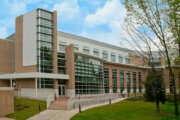WASHINGTON — Ask any bike commuter, and they’ll tell you: D.C.’s bike lanes are not always a refuge from truck and automobile traffic.
“I probably see at least two or three cars on every trip that I go on parked in a bike lane somewhere,” says Greg Billing, advocacy coordinator with the Washington Area Bicyclist Association.
Some drivers don’t just park in D.C.’s bike lanes — they drive in them.
Craig Chester works on L Street in Northwest. He says he’s actually had a car trail him inside the L Street cycle track, “and a driver came up behind me, honking, basically telling me I wasn’t going fast enough in the bike lane.”
Chester has taken over a local blog entitled “Who’s Blocking the L Street Bike Lane Today?”
Regular bike commuters say they see it all the time. Cyclist Nick Blanton says that as far as he can tell, drivers who cut into the bike lanes on L Street aren’t confused; they use the cycle track, he says, “because it’s wide enough to have a vehicle on it.”
There is an area of the L Street cycle lane that allows cars to cut into the lane to make a left turn. Those areas, where cars and bikes may merge to allow cars to make a left or right turn, are called “mixing zones,” and they require drivers to be on the lookout for cyclists.
But many drivers cut into the bike lanes well before those mixing zones, and the problem isn’t new.
Last November, when D.C. Council member Mary Cheh joined business leaders to unveil a new bike rack on L Street, she witnessed up to 15 cars zipped into the bike lanes. Cheh, a cyclist herself, was surprised to see it. When a D.C. government vehicle slid into the bike lane, Cheh shook her head.
“Now see, that — to me — is totally unacceptable. Our own government truck?!” she said.
Billing says the problem isn’t restricted to L Street, and with the growing popularity of cycling as a method of transportation, it’s increasingly important that every road user follow the rules. Billing says drivers benefit when the bike lanes are clear.
“It makes it easier for them to get by us and for us to go at our own pace as well,” he says.
Billing says that when cyclists can stick to the bike lanes, it also eliminates something that aggravates so many drivers: the unpredictability of some bike users.
Recently Billing was honked at by a driver who was upset when he shifted from the bike lane into the traffic lane.
“When we got to the next stop light, I motioned to her to roll down the window and I explained that the reason I moved into the car lane was that the bike lane was blocked by three vehicles.”
Billing says the woman didn’t apologize for honking, but did recognize that because of the blocking vehicles, he had nowhere else to go.
Drivers often complain that bikes are all over the road, weaving between cars and running red lights. Pedestrians complain that the growing number of cyclists on the roads has some taking to the sidewalks, often startling people on foot.
It’s legal for bikes to travel on D.C. streets, and while the law says bikes should stay to the right, it specifies that they should stay as far right “as practicable.” Advocates say that definition changes with road conditions. Potholes, debris and parked cars can force a bike to the left.
Riding on the sidewalks is legal in the District of Columbia, though not in what’s called the Central Business District.
It’s easy to start a debate on who’s the bigger scofflaw: drivers who speed, or text while driving; cyclists who ignore the rules of the road; or pedestrians who cross against the light or jaywalk. But Billing says for everyone to be safe, and even have a pleasant time getting where they’re going, it’s simple.
“We all have to follow the rules,” he says.
Who’s enforcing the law?
When it comes to making sure the bike lanes are reserved for bikes, the Metropolitan Police Department, the Department of Public Works and the D.C. Department of Transportation have officers and staffers who issue tickets.
The fine for stopping, standing or parking in a bike lane is $65, and according to MPD statistics, 4,236 citations were issued in calendar year 2013. That’s up from 2012’s total of 3,281.
Below is a video showing parking enforcement speaking with a driver in the bike lanes:
WTOP’s Kate Ryan contributed to this report.
Follow @WTOP and @WTOPTraffic on Twitter and WTOP on Facebook.









